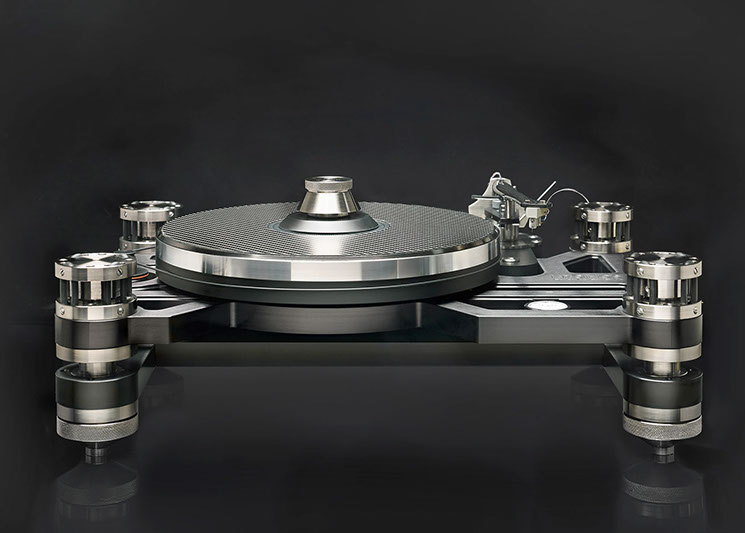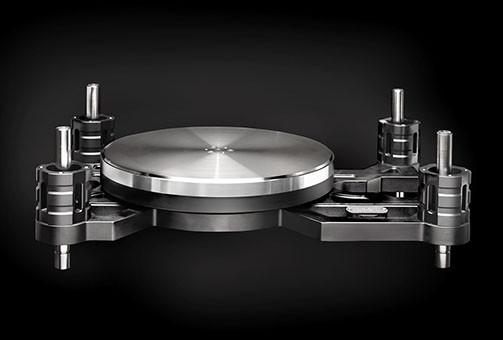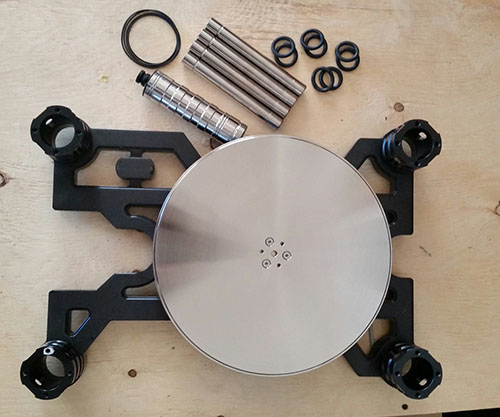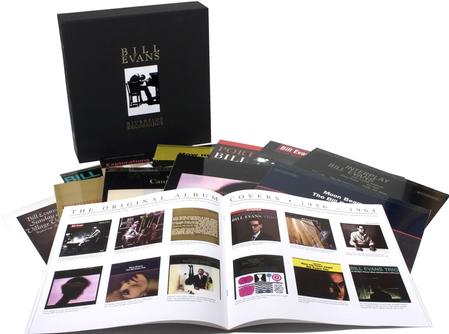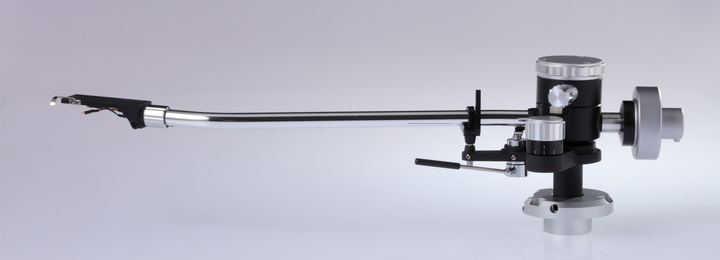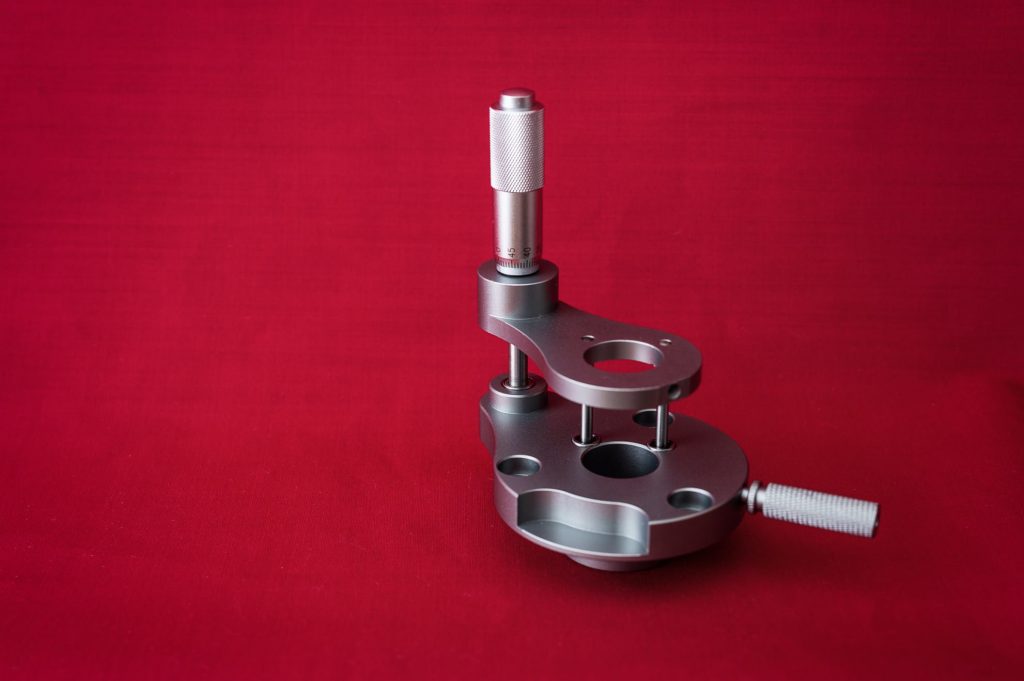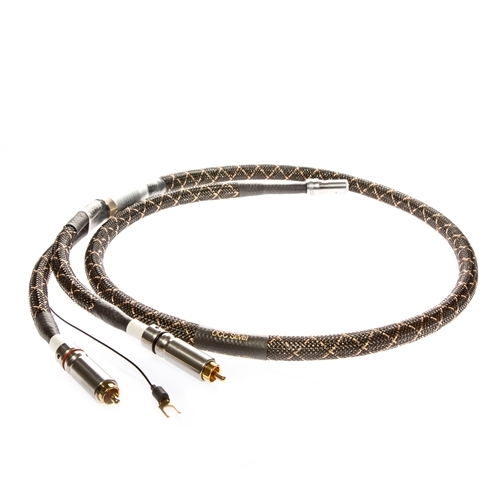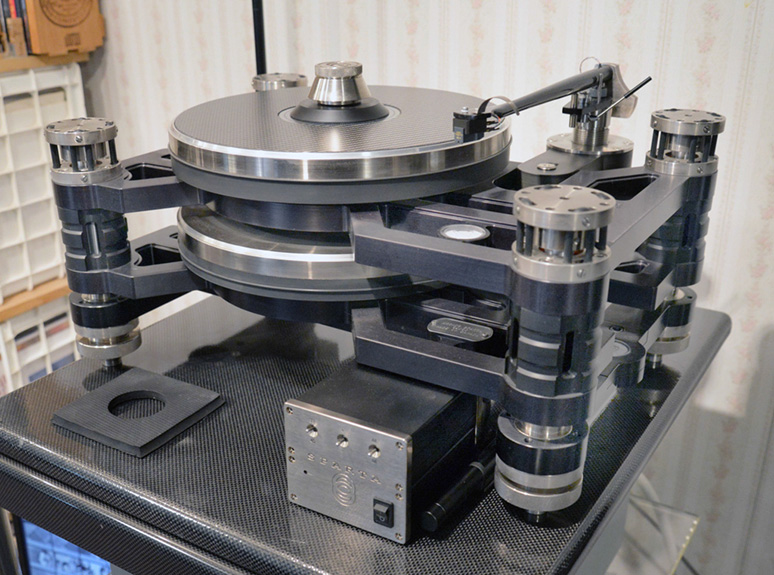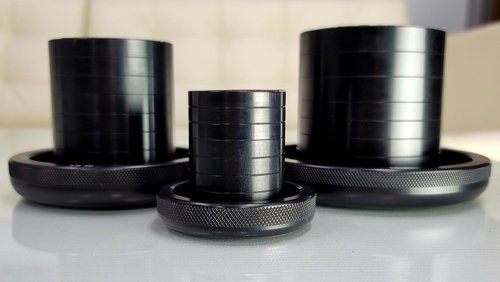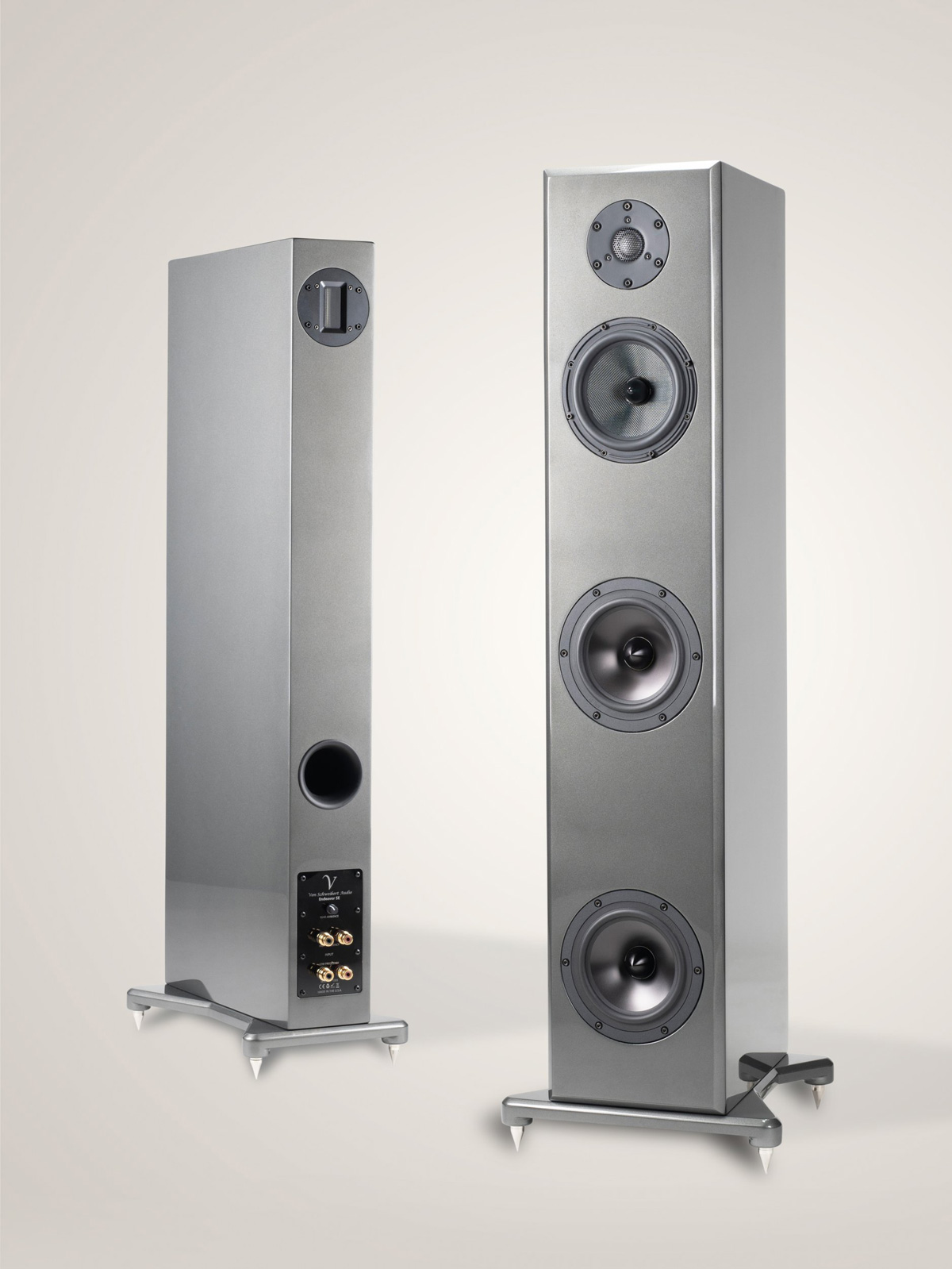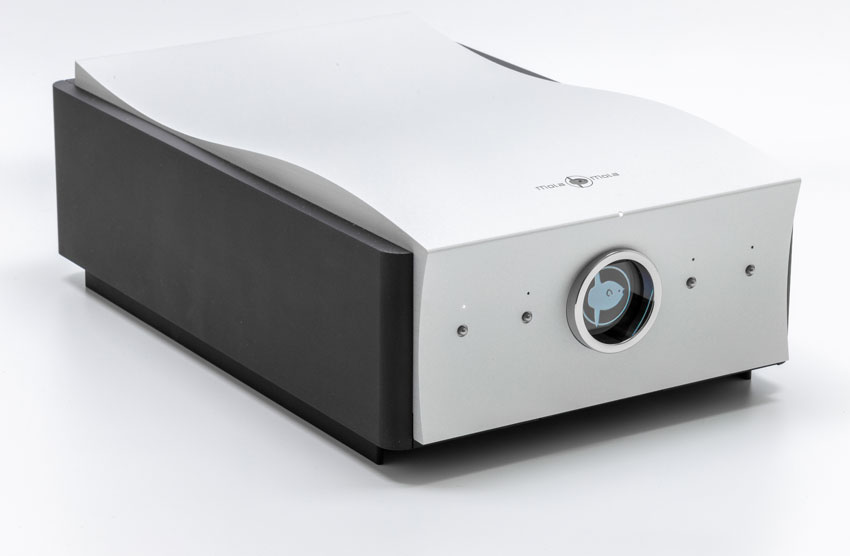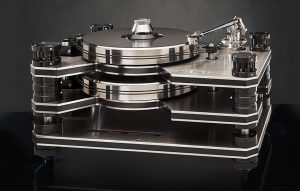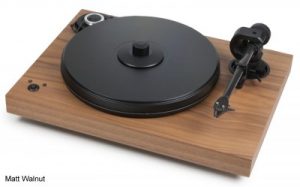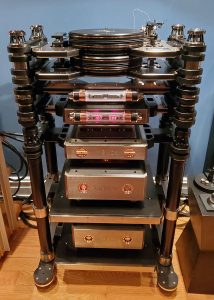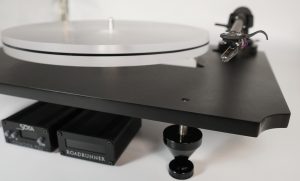I first raved about the stunning Kronos Sparta 0.5 turntable back in the fall in a teasing preview report (HERE). In my opening salvo, I described the sound of the littlest, but hardly little, Kronos turntable (the model weighs roughly 50 lbs. and measures a healthy 20 in (W) x 14 in (D) x 7 in (H)) as gravity-defying, delivering marmoreal bass reach and impact, cut from spun glass upper octave purity and air, laser-quick transient precision, stunning midrange articulation, stellar staging, and low self-noise.
In the many months since the 0.5 took up residence here at Casa Jeffries, my esteem and love for this middleweight sleeper has only deepened.
Photo courtesy of Kronos Audio
Why do I call the "baby" Kronos a sleeper? Simple. When most folks think (and talk) about design wunderkind Louis Desjardin's remarkable turntables, they typically have in mind either the full-blown Sparta (now upgradeable with the new and apparently stunning Sparta Super Capacitor Power Supply (SSCPS)) or the fully tricked-out Pro, a model that I consider one of a handful of the finest turntables in the world. So, while the 0.5 borrows its cutting-edge design and styling cues, modular construction architecture, and overall operational gestalt from the bigger and pricier Sparta and Pro models (but lacking the vibration-nullifying counter-rotating platter and associated upgraded suspension), it isn't the hot topic within high-end turntable gossip circles.
This is a real shame. In my estimation, the 0.5 deserves recognition as a top contender in the under-$20K price category, and proof-positive that Montrealer Louis Desjardin can design brilliantly engineered, beautiful to behold, lovely sounding kit without benefit of the counter-rotating platter arrangement that first brought Kronos high-end audio fame.
"Trickle-Down" Architecture
But make no mistake, even without the dual-platter arrangement, the newest member of this distinguished turntable family remains, in all important respects, nothing more and nothing less than a pure and undiluted distillation of the Kronos / Desjardin design ethos. Like its bigger brothers, the 0.5 is a sui generis animal that ingeniously weds mass loading design techniques to the long-recognized benefits of suspended turntable isolation. Fully assembled, the Kronos speaks visually with the same "I kick ass" bravado and "ain't I pretty to look at" design swagger as a top-model Ferrari, or the stunning Corvette ZR1, if over-the-top domestic muscle cars strike your fancy (they do mine).
From the beautifully textured finish of the cut-away black aluminum plinth (the overall look resembling a minimalist modern sculpture as much as a new millennium high-performance turntable), to the sophisticated engineering of the constrained layer-damped platter (topped with an integral carbon fiber mat upon which your records sit directly), to the novel support pillar / footer towers that stealthily conceals the novel rubber wire-tuned suspension mechanics, the 0.5 is all business.
Speaking of turntable suspensions, the ingenious isolation system employed in the 0.5 (and in the Sparta and Pro, too) stands head and shoulders above the coiled piano spring-based suspension systems used in tables like the venerable Linn LP12, my vintage Thorens TD 125mk.II, and current suspended models from American manufacturer SOTA. For starters, traditional steel coiled suspension systems are often notoriously difficult to set up (and to keep in alignment). Just ask any dealer or dedicated owner of an LP12. Second, these old-school coiled systems don't always behave in a consistent fashion, meaning that their filtering abilities are neither stable nor predictable. Lastly, traditional coiled springs are largely ineffective at filtering out lateral distortions, meaning vibrations that "attack" the turntable suspension system side-wise.
Photo courtesy of Kronos Audio
This doesn't mean that the suspension systems used by Linn, SOTA, and Thorens are "broken."
They aren't. These tables all do a respectable job suppressing vibrations that compress the springs top to bottom. Tap the platter on one of these coil-suspended models and the platter / bearing / tonearm assembly will, when set up properly, "bounce" consonantly with the vibrations, effectively filtering out the incoming vertical fluctuations to lessen their impact on the delicate tonearm / stylus interface.
On the other hand, these systems are less effective at damping or filtering out side-wise, or so-called lateral deflections. In a nutshell, a traditional piano coil's effectiveness is greatest when suppressing vertical vibrations, less so when attacked horizontally or "laterally." Push that same Linn or Thorens table from the side with enough force, and the stylus will "skit" across the vinyl uncontrollably. This owes to the simple fact that old school piano coils do not compress sufficiently when confronted by disruptive sidewise movements.
As a result, the sonic footprint of these "hey boomer" designs can best be described as an amalgamation of (1) the sound generated by the generally effective filtration of destructive vertical vibrations away from the delicate vinyl / stylus / tonearm interface and into the system's mechanical filters or coils, and the remaining (2) lateral vibrations that the coils cannot filter out completely and that, while largely inoffensive in their sonic character, nevertheless end up disrupting the, here we go again, delicate vinyl / stylus / tonearm interface, however subtly.
Think of these "unfiltered" lateral deflections as the mechanical equivalent of the 2nd order harmonic distortions that make some tube amps sing sweetly. Such distortions do not sound bad necessarily, at least to most ears, but they do add a bit more sugar and cream to the mix than might occur naturally.
Seeking to engineer their way around the lateral deflection problem, some manufacturers have taken to using CNC-machined coils to suspend their tables, such coils exhibiting far greater immunity to lateral vibrations than their piano-coil counterparts (the defunct Merrill-Scillia Research turntable line comes to mind here). Kronos has taken yet a different approach, using in its growing line of tables the rubber wire-tuned suspension system described above. Since each of the 0.5's four suspended support towers employ several "looped" round and fat rubber "bands" (looped vertically versus the horizontal looping seen in the Avid HiFi turntables, the latter using similar round bands plus old school coils to suspend their top turntables), the Kronos system exhibits the same "pogo-stick" up-and-down bounce that one observes with traditional suspended designs, plus the heightened lateral stability of a CNC-machined counter-rotating coil owing to the sheer number of fat bands used.
This novel suspension architecture gifts the 0.5 with the exceptional micro-dynamic expressiveness that made so many listeners fall in love with the musicality of the "difficult to keep stable" Linn LP12, along with the heightened stability and freedom from external noise that characterized the fine-sounding Merrill-Scillia models. I'll have more to say about the sonic benefits of the 0.5's hybrid "suspension + mass-loaded" isolation system below. For now, know simply that Kronos's novel approach significantly enhances dynamic expressiveness and overall realism when compared to most old school suspended turntable designs.
Photo courtesy of Kronos Audio
As I hinted above, the vibration damping measures don't end with the 0.5's "fat band" suspension system. Despite the absence of Kronos's signature counter-rotating second platter (a $7,500 upgrade over the 0.5's $16,500 base price, sans tonearm) and supporting plinth assembly, the Sparta 0.5 remains a two-level concoction, and for good reason. Look closely and you'll notice that the lower level of the plinth employs the rigid, vibration-damping, mass-loaded design strategy that has become commonplace in the high-end. Constructed of the same textured black aluminum as used to construct the cut-away upper plinth (suspended), the lower plinth assembly (which appears to the eye as a monolithic aluminum slab that resembles the letter "I") essentially functions as a massive support foundation for the suspended upper levels (meaning, again, the cut-away upper plinth, the platter and platter bearing assembly, and the arm board / tonearm assembly).
It should be apparent, given the near-fanatical attention to manufacturing detail, vibration suppression, overall design cohesion, and raw sonic performance, that the 0.5 packs as much imaginative technology and performance firepower into its compact frame as some company's top-of-the-line offerings.
Living with Only One Platter
Each of the 0.5's distortion-reducing, vibration filtering, noise damping strategies pays major sonic dividends, even with just one platter. The result of all this attention to noise suppression manifests the instant the stylus hits the lead-in LP groove. From the opening notes, the 0.5 delivers superb rotational stability, incredible pitch consistency and composure, depth-charge like dynamic expressiveness, and near master-tape levels of continuousness and flow, the latter an area where I feel that the best vinyl playback systems still reign supreme when compared to the best digital sources (although I admit that the performance gap between the two camps continues to shrink at an alarming rate).
Take a highly regarded reissue like Analogue Production's lovely Bill Evans: Riverside Recordings Box Set (all 45 RPM LPs, 22 of them). These Riverside gems, the earliest of which dates to 1956, the latest to 1962, capture the young pianist just as he and his cohorts were beginning to explore the outer reaches of the traditional trio format. An historic encounter with Miles Davis, John Coltrane and a cadre of like-minded associates on 1959's seminal Columbia release Kind of Blue would infuse Evan's impressionistic palette with a frisson of the moody, angular modal musings that Davis and Coltrane favored. Evans' lyrical assimilation of the two streams would yield a playing style of singular expressiveness in modern American jazz, one that continues to influence subsequent generations of jazz pianists.
But these Riversides aren't perfect. Tape hiss, vinyl surface noise, and wow and flutter, while relatively low in absolute terms, still rear their ugly heads from time to time. This is most evident on musical sustains, where one can quite easily detect the occasional waveform "wobble" and associated deviations from absolute pitch consistency. The 0.5 doesn't banish such distortions to the ether. Nothing can if such bugaboos are embedded within the tape's, and / or the LP's, generative DNA.
What the 0.5 does do, if not quite to the same extraordinary level as its bigger, pricier brethren, is filter, damp, and mechanically suppress external vibrations, along with any significant sources of self-noise, to such marginal quantities that, in practice, only the sound of the vinyl and the tonearm / stylus interface remains. This wholesale suppression of external and self-generated sources of noise has the sum effect of minimizing, sonically, distortions inherent to the vinyl medium itself. So, on Evans's path breaking masterwork Sunday at the Village Vanguard, the 0.5, despite the occasional tape drop, pitch wobble, and associated sonic pumpkin, lets you both hear and feel the unbridled sense of electrical urgency that Evans, bassist Scott LaFaro, and drummer Paul Motian generated that day, the martini-numb audience apparently oblivious to the fact that they were in the presence of musical giants on the cusp of revolutionizing the modern jazz piano trio.
Photo courtesy of Acoustic Signature
How does the 0.5 accomplish this remarkable feat? Remember, the sound we hear from the speakers is the sum of the sound of the vinyl, the tonearm / stylus interface, and the remaining distortions generated by everything else in one's system (including the incoming AC if not properly filtered). When we eliminate, or significantly reduce, one or more of these distortions, the sound from the speakers emerges as purer, clearer, more coherent, and more refined.
Careful listeners, even non-audiophiles, perceive this phenomenon as a net enhancement of musical intelligibility, coherence, and overall transparency, even as the annoying pops, ticks, and wobbles that remain part and parcel of the vinyl experience persist. Only now, these annoying pops, ticks, and wobbles occupy their own sub-space region, making it easier to listen around them, better to focus on the music, the latter now easier to comprehend and appreciate.
The 0.5's sheer quietude means that recordings with impact and musical momentum sing unimpeded. John Coltrane's recently unearthed Both Directions at Once (Impulse) LP, the languid musings of pianist Bill Evans on the aforementioned Riverside Box Set, and the infectious lyricism, wry wit, and boundless harmonic ingenuity of tenor saxophonist Stan Getz unpacking Luiz Eca's evocative The Dolphin from Getz's 1981 Concord Jazz release of the same name, bloom with a disarming sense of composure, control, and sheer musical conviction that, if not unrivaled, are certainly rare.
This noiselessness also makes it quite easy to discern sonic differences between the various phono stages and turntables that I've had access to over the past year. I could, for example, easily identify the essential sonic footprint of the 0.5 from that of other fine turntables like the outstanding Origin Live Resolution Mk. III (review coming soon) and the Kid Howard turntable / Cornet 2 tonearm suite that I recently reviewed (HERE), regardless of the phono preamp used. Both the Kronos and the OL table / tonearm combo enthrall with their class-leading transient precision and punch, while the Kid Howard combo seduces with softer transients, creamy textures, and remarkable sweetness.
By the same token, the Kronos pulls ahead of the lower-priced turntables by transcribing LPs with the musical equivalent of black hole-like force and impact. If the Kid Howard turntable / Cornet 2 tonearm teases and lulls one sweetly and seductively into the music, and the OL combo musically engages and electrifies with lightning-quick transient precision and laser-crisp image focus, the Kronos literally overwhelms with its gravity-defying scale and gravitas, sweeping into its inescapable two-tiered, mass loaded, spring propelled musical orbit any stray sonic neutrons and electrons that dare to get out of line.
The Stellar Supporting Cast: The Jelco TK-950S 9-inch Tonearm, the Easy VTA, and the Audio Sensibility Signature Silver Angle DIN to RCA Phono Cable
Some of you may question why I chose something like the "humble" Jelco TK-950S 9-inch tonearm to pair with a $16,500 turntable typically mated to the upper-crust $6500 Helena tonearm from Kronos. The answer is simple: I wanted to explore what the 0.5 is capable of sonically when paired with real-world (and sanely priced) supporting products. Indeed, it was none other than Bill Parish, the head-honcho at GTT Audio & Video (the U.S importer of the Kronos gear), who suggested the Jelco / Sparta 0.5 pairing to me, one he recommends to audiophiles ready to enter the Kronos universe, but who lack the coin to secure the matching Helena arm.
The TK-950S is a real beauty, a superbly musical arm whose build quality and sonic performance belie the relatively low asking price. The TK-950S utilizes what Jelco calls a "two-way" balancing system that can operate both dynamically and statically. In a delightful "looking to the past" design move, one that will ring nostalgic for fans of vintage SME tonearms, the TK-950S utilizes a low friction, hand-made knife-edge bearing system. Here the knife edge is constructed of a super hardened steel said to enhance operational and tracking stability and facilitate smooth operation.
The tonearm is a relatively high mass design, making it well-suited to medium and low compliance moving coils like my beloved Zu / Denon. The tonearm geometry allows for a Baerwald alignment which is what the IEC (the International Electrotechnical Commission) recommends. The universal counterweight accommodates cartridges that weigh anywhere from 17 to 35 grams (including the weight of the removable head shell).
What the TK-950S lacks is any form of repeatable VTA adjustability. The rationale is the same offered by Rega for omitting any type of fine VTA adjustability in its extensive line of tonearms: at any given price point, if the designer must choose between tonearm rigidity and VTA adjustability, choose enhanced arm rigidity. Jelco has chosen the same "rigidity over adjustability" pathway. If you need to adjust the arm's VTA, the TK-950S functions as an unapologetically old school device. This means loosening the mounting bolts that secure the arm to the mounting collar and manually raising the arm up or down to make coarse VTA adjustments.
Given the arm's thoughtful design and lovely build quality, I was a bit surprised to discover that it offered no form of fine VTA adjustability, something I needed in order to dial in my Zu / Denon MC accurately. A brief internet search answered my prayers in the form of the outstanding Easy VTA, an ingenious after-market VTA adjustment device. After several email discussions with the Easy VTA team, a small box containing the tower / collar assembly arrived in the mail and promptly took its place on the Sparta 0.5.
The Easy VTA, created and sold by Portuguese high-end retailer and distributor Purus Audio (HERE), is a micrometer-based VTA adjustment tower, the tower mounted to and supported by a lovely CNC-machined replacement collar for Jelco and other tonearms. I especially appreciated the inclusion of the replacement mounting collar in the design since one of the three screw holes pre-drilled into the Jelco-supplied collar refused to accept the supplied mounting screw. The Easy VTA tower /collar device clamps around the tonearm pillar and allows the user to raise and lower the arm in extremely small increments via a beautifully machined knurled stem / knob assembly. The replacement collar accepted the supplied mounting screws without fuss or fiddling, making for a solid and smooth overall fit.
Photo courtesy Purus Audio
Please follow the included link (HERE) to watch the Easy VTA's man in charge, Antonio da Silva, demo the device in action. As of the time of publication, Antonio informed me that "a Universal Easy VTA for several tonearm shaft diameters and the very anticipated Easy VTA for SME" will soon come to market.
Apart from its movie star good looks, the Easy VTA does just what it claims: makes using the Jelco TK-950S tonearm a sheer delight. When securely mounted to the 0.5 arm board assembly, the Easy VTA allows the Jelco arm to perform smoothly and without fuss. The knife-edge bearing assembly gifts the arm with a supremely confident touch and feel, delivering a colorful, meaty, vibrant presentation that always serves the music. I dialed in the beefy Zu / Denon cartridge at a forceful 2.3 grams and have yet to experience a single tracking problem. In my estimation, at a combined cost of about $2,449, the TK-950S / Zu / Denon / Easy VTA partnership seems hard to beat, especially if you value musical moment and impact, solid overall coherence, and rich tone.
The cost of the Easy VTA: $149. This little device represents one of the finest audio bargains I have come across, and a great accessory for anyone using a Jelco tonearm.
One final setup detail deserves comment. Those of you familiar with Jelco's extensive line of tonearms know that the firm, and most retailers, sells the arms sans phono cables. Of equal import, Jelco uses a DIN connecting mount assembly, meaning that your chosen cable must feature either DIN-to-RCA or DIN-to-XLR phono cable terminations to operate. For this review, Canada-based cable maker Audio Sensibility provided me with a run of its lovely Signature Silver Angle DIN to RCA phono cable for use with the Jelco arm, a pairing of remarkable synergy and impressive value. At roughly $800, the Signature Silver cable looks, feels, and sounds like it should cost a whole lot more. It possesses all the hallmark qualities I have come to expect from Audio Sensibility cables, namely low noise, balanced tone and timbre, very good micro-dynamic composure, superb build quality, and exceptional value.
And word has it that fellow Canadian Louis Desjardins likes the Audio Sensibility cables as much as I do, though he prefers the many times more expensive Kubala-Sosna Realization line as his current references.
Photo courtesy Audio Sensibility
Nowhere to go but up!
As fine a pairing as I found the 0.5 / Jelco arm to be, I can't quite escape the nagging feeling that the cartridges and phono stages that I have on hand didn't, and can't, tease out all that the table / arm combo can deliver musically. For starters, as convincing and musical as they are, the Dynavector and Zu / Denon MCs seem to reign in what the Kronos / Jelco team can deliver in terms of low bass extension, power, and impact, upper-octave air, midrange palpability and bloom, and soundstage transparency. Make no mistake, both are standout performers, but their strengths and weaknesses speak more commandingly when paired with the superb OL combo.
By the same token, although the Parasound JC 3+, the Sutherland 20/20 and Little LOCO (review forthcoming), and Mola Mola Makua phono stages all performed commendably, they too lacked the sheer upper-octave air and extension, dynamic clout, micro-dynamic expressiveness, midrange transparency, and overall musical gravitas to exploit fully what I know the Kronos to be capable of delivering.
A number of upgrades are on the horizon, including a new arm board so that I can give the mighty and mighty fine sounding OL Conqueror tonearm a spin, as well as MC cartridge upgrades that will likely include an Ortofon or two, plus (hopefully) a go-round with one or two top-flight models from a couple of venerable Japanese manufacturers.
In the here and now, the Kronos / Jelco combo has totally captured both my head and heart. While some might think of the 0.5 as half a Kronos Sparta, I suggest instead that they feel, touch, hear, and appreciate the 0.5 for what it really is: a beautifully engineered, finely crafted, near state of the art assault on sub-$20K turntable designs that offers superb sonics and exceptional value.
Should the upgrade bug bite, one can investigate a better arm, a better cartridge, a better phono stage, or heaven forbid, consider going the Full Monty by adding Kronos's counter-rotating platter, the superb Helena carbon fiber tonearm, and the elaborately designed SSCPS. It's here that the true "hidden" value of the 0.5 lies. Instead of selling your 0.5 to step up to a better performing model, users can instead retain their considerable investment (including all those carefully chosen supporting components) simply by adding the upgrades, either all at once, or singly as funds permit. No hassles, no price depreciation worries, no resale haggling, no replacing existing supporting components because your new table has, quite unexpectedly, altered the sound of the rest of your system.
In other words, one should consider a 0.5 not only for its great sound, but also because its ingenious modularity and upgradability offers the best insurance policy against turntable obsolescence.
Parting Thoughts
With the obvious caveat that the Sparta 0.5 / Jelco / Zu-Denon (or Dynavector) combo used for this review will not deliver quite the slam, sparkle, speed, and life of a Sparta 0.5 / Helena tonearm partnership—along with an appropriately chosen top-flight phono cartridge—let me wrap things up by saying that these superbly colorful, infectiously dynamic, and remarkably balanced sonic overachievers do just what I want from a near top-flight, almost sensibly priced (in high-end terms, of course) vinyl rig: namely, they get on with the business of making music in the most engaging and involving of ways, with nary a hiccup, bump, or wrong-foot put forward.
I'm seriously considering adopting the Baby Kronos as my new reference turntable. And no, damnit, I haven't yet figured out how I'm going to pay for the bloody thing if I do decide to keep it! I'll keep everyone posted.
Until then, these analogue marvels come very highly recommended!
Kronos Sparta 0.5 Turntable
Retail: $16,500
Kronos Audio
U.S. Distributor Kronos Audio
GTT Audio & Video
356 Naughright Rd.
Long Valley, NJ, 07853
USA
908.850.3092
Jelco TK-950S 9-inch Tonearm
Retail: $1259 (USD /approx.)
https://www.jelco-ichikawa.co.jp/
Signature Silver Angle DIN to RCA Phono Cable
Retail: $800 (USD /approx.)
Source for the tonearm and cable:
Audio Sensibility
3 Mylesview Place
Toronto, Ontario
Canada M2N 2M7
416.953.8898
https://audiosensibility.com/blog/
Easy VTA
Retail: $149 (USD /approx.)
Purus Audio
http://www.purusaudio.pt/easyVTA.html




